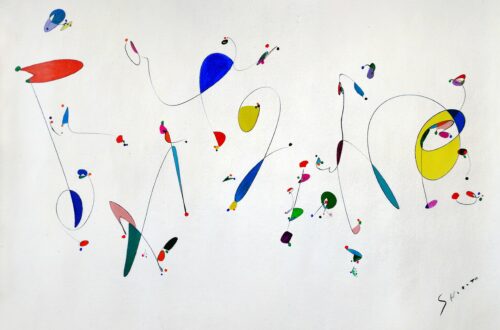No. 61 (Rust and Blue) is an example of Mark Rothko’s famous multiform artworks, yet also heralded an important step in the Color Field movement. Rothko’s works were infamous for creating an almost religious experience for viewers, but how exactly did these rectangular blocks achieve this goal? In this article Singulart will be exploring the question of why Rothko’s art is considered to be among the most emotionally impactful art ever created, as well as delving into the philosophy of the Color Field movement and examining how it relates to No. 61 (Rust and Blue).
The visceral impact of Rothko’s art
Modern art, particularly abstract art, is often derided with an ideal that “Well, my kid could have drawn that”. However, particularly in the case of Rothko’s multiforms, there is a complicated, thoughtful premise behind the artworks. Rothko explained that “[shapes] have no direct association with any particular association with any particular visible experience, but in them, one recognizes the principle and passion of organisms”, further clarifying “painting is not about an experience… it is an experience.”
It has been suggested that Rothko is the artist that most consistently brings viewers to tears – to bring credence to this fact, the Rothko Chapel in Texas is surrounded not only by security guards, but also apparently by counselors ready to console those who are moved to tears by viewing his seminal work. Although Rothko painted on a large scale (particularly for the time period), he stated that viewers should stand at around eighteen inches away from his works, serving to be fully encapsulated by the piece, stating “I paint big to be intimate”. Curator Gwen Chanzit said:
“If you’re looking at a painting by Rothko, you need to give it time, so that you can almost lose yourself within that canvas… You can’t walk by a Rothko and get very much out of it. But if you spend the time to immerse yourself within it, that’s when there’s a reward.”

No. 61 (Rust and Blue) and the Color Field Movement
Rothko did not consider himself to be particularly aligned to the Color Field movement, although he was one of the most prominent artists of the style, particularly exemplified in No. 61 (Rust and Blue). The Color Field Movement began in the 1940s, defined as artworks featuring large, flat blocks of color spread across the canvas, achieving an unbroken effect as the shapes blended into the background.

Courtesy of www.Mark-Rothko.org
The Color Field movement was particularly tied to abstract expressionism, and developed by artists such as Rothko, Clyfford Still, and Barnett Newman. The phrase was coined by art critic Clement Greenberg, who believed that the Color Field movement represented a forward direction for art, in opposition to the academic qualities of other 1940s artists. In his 1955 essay American-Type Painting, he stated that the movement advanced the technique of using large blocks of color, or ‘fields’, which he saw as a return to the art of the impressionists.
The use of color by the artists involved in the Color Field movement was abstract and contemplative, rather than emotive. They used techniques such as pouring paint, as opposed to using a brush, and stressed the importance of the relationship between paint and canvas. The form and background are all intrinsically tied together, with the aim to create an emotional response from the viewer.
No. 61 (Rust and Blue)
No. 61 (Rust and Blue) is considered a fine example of the Color Field movement as it features variations on a monochromatic hue. The artwork features a maroon-hued, rust rectangle atop a light blue rectangle, with a purple-blue rectangle taking up the bottom space of the piece.
Although the painting is in a darker hue than, for example, Orange and Yellow, it still creates the essence of luminosity that Rothko aimed to achieve in his work. Similarly to Rothko’s other pieces in his multiform series, paint can be seen running upward across the canvas, due to the fact that Rothko would often invert a picture while completing it. Occasionally he would change the orientation of the painting completely at a late stage.










